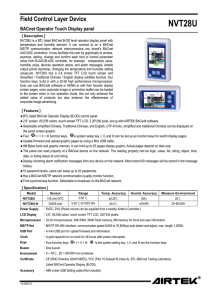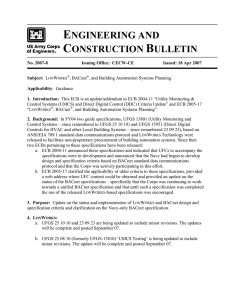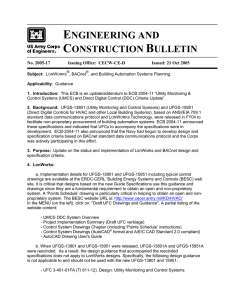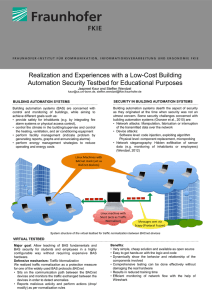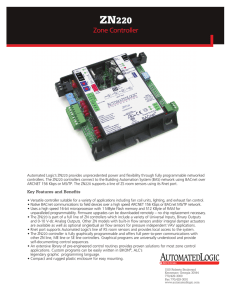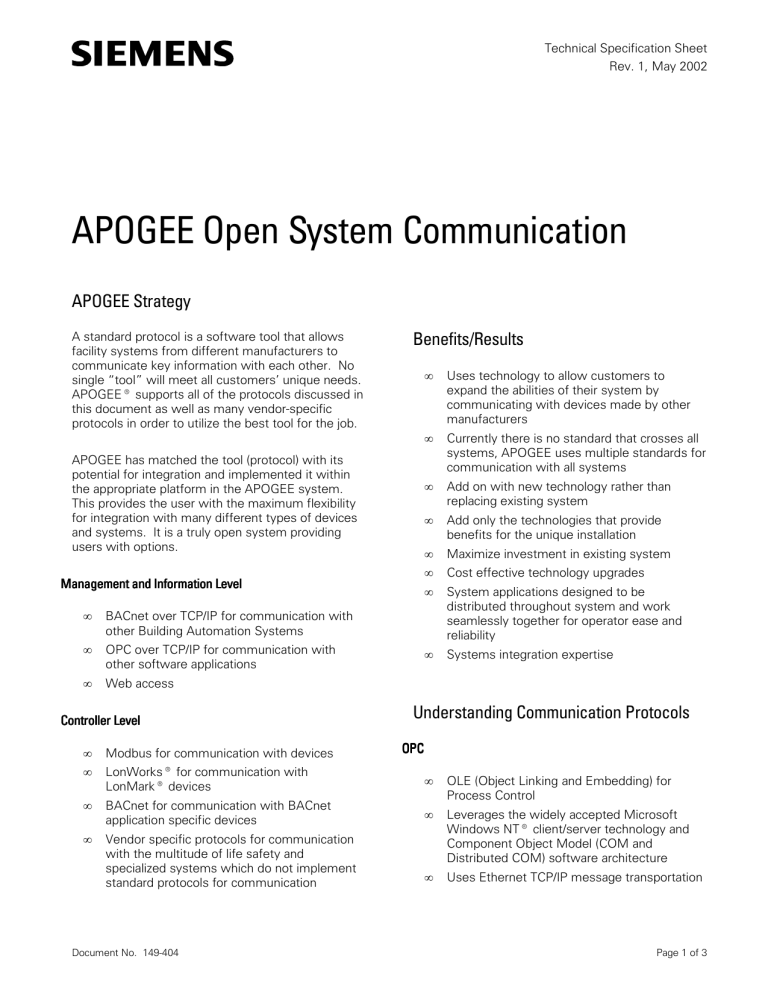
Technical Specification Sheet Rev. 1, May 2002 APOGEE Open System Communication APOGEE Strategy A standard protocol is a software tool that allows facility systems from different manufacturers to communicate key information with each other. No single “tool” will meet all customers’ unique needs. APOGEE® supports all of the protocols discussed in this document as well as many vendor-specific protocols in order to utilize the best tool for the job. Benefits/Results APOGEE has matched the tool (protocol) with its potential for integration and implemented it within the appropriate platform in the APOGEE system. This provides the user with the maximum flexibility for integration with many different types of devices and systems. It is a truly open system providing users with options. Management and Information Level • BACnet over TCP/IP for communication with other Building Automation Systems • OPC over TCP/IP for communication with other software applications • Web access Controller Level • Uses technology to allow customers to expand the abilities of their system by communicating with devices made by other manufacturers • Currently there is no standard that crosses all systems, APOGEE uses multiple standards for communication with all systems • Add on with new technology rather than replacing existing system • Add only the technologies that provide benefits for the unique installation • Maximize investment in existing system • Cost effective technology upgrades • System applications designed to be distributed throughout system and work seamlessly together for operator ease and reliability • Systems integration expertise Understanding Communication Protocols OPC • Modbus for communication with devices • LonWorks® for communication with LonMark® devices • • BACnet for communication with BACnet application specific devices OLE (Object Linking and Embedding) for Process Control • • Vendor specific protocols for communication with the multitude of life safety and specialized systems which do not implement standard protocols for communication Leverages the widely accepted Microsoft Windows NT® client/server technology and Component Object Model (COM and Distributed COM) software architecture • Uses Ethernet TCP/IP message transportation Document No. 149-404 Page 1 of 3 • Focus is on sharing information between workstation applications as opposed to end devices • Future revisions will likely support the XML (Extensible Mark-up Language) standard for Internet friendly data formatting • Interoperability testing is available with the OPC foundation-sponsored interoperability conference • Compliance testing is available through the OPC Foundation • System level functionality and applications are vendor-specific TCP/IP Ethernet • The most common communication media for Local and Wide Area Networks. • Can transport multiple communication protocols such as OPC and BACnet. LonWorks • Communication level protocol widely used by application level devices • Provides for integration through conformance to device profiles • LonMark Interoperability Consortium provides device profiles through task groups • Each LonMark device includes a Neuron microprocessor • Peer-to-peer communication allowing application specific devices to communicate directly with each other through binding of variables • System level functionality and applications are vendor-specific Modbus • Device level protocol widely implemented due to simple process of reading and writing values Internet • Enhances user access to information • • Provides access to system without loading any software other than a web client such as Windows Explorer Designed for process control applications, but has become equally valuable in BAS application • Not regarded as a native system protocol within the building automation systems industry as it is in the process control industry BACnet • A standard protocol developed by the American Society of Heating, Refrigeration and Air Conditioning Engineers (ASHRAE) consortium and recognized by the American National Standards Institute (ANSI) • Commonly supported by Building Automation and HVAC systems • Integration capabilities for many non-HVAC control systems • Accepted worldwide for the management and building levels of building automation systems • Controllers and devices using BACnet are generally not interchangeable between manufacturers due to vendor specific application functions, programming languages, and configuration tools • Implementation description through BIBBS (BACnet Interoperability Building Blocks) • BACnet Testing Laboratories (BTL) performs testing of products to BACnet Standard Page 2 of 3 The language of protocols General Protocol - Defines how devices on a network exchange information Standard Protocol - Protocol must be easily attainable, commonly available, and widely understood BACnet (Building Automation Control Network) BIBBS (BACnet Interoperability Building Blocks) define BACnet functionality that is needed to perform a particular task. Conformance Classes and Functional Groups defined portions of the BACnet standard to be used to write clear and useful specifications. Experience in the field has shown that this approach does not work and they have been eliminated. In their place is a new approach of BIBBS and five areas of interoperability. Siemens Building Technologies, Inc. "Interoperability areas" (IAs) - BIBBs are organized into five interoperability areas to describe functionality. The five IAs are data sharing, alarm and event management, scheduling, trending, and device and network management. BACnet Manufacturer’s Association (BMA) - a notfor-profit, independent organization that uses interoperability testing, educational programs and promotional activities to advance the success and application of the BACnet protocol as an interoperability tool. BTL - The BMA has formed the BACnet Testing Laboratories (BTL) to support compliance testing and interoperability testing activities, and will develop conformance certification and listing programs LonWorks LonWorks – an encompassing term that includes the LonTalk protocol, devices that use the LonTalk protocol, and the network that the devices reside on LonTalk – open protocol for peer-to-peer communication of application specific devices LonMark – the mark awarded to devices which implement the profile for their specific device type. The profile defines required inputs and outputs for the device. Echelon – corporation that developed the LonTalk protocol and LonWorks technology LonMark Interoperability Association – through work groups creates device profiles for application specific devices enabling interoperability Neuron – microprocessor chip which implements the LonTalk protocol for all devices on a LonWorks network Transceiver – physical media interface to a LonWorks network LNS – a database from Echelon that supports the LonWorks technology LonMaker – a tool from Echelon that interfaces to the LNS database PEAK – a database from IEC that supports the LonWorks technology ICELAN – a tool from IEC that interfaces to the PEAK database Echelon, LonTalk, Neuron, LonWorks, and LNS are registered trademarks and LonMaker is a trademark of Echelon Corporation. BACnet is registered trademark of the American Society of Heating, Refrigerating and Air-Conditioning Engineers, Inc. APOGEE is a registered trademark of Siemens Building Technologies, Inc. ©2002 Siemens Building Technologies, Inc. Siemens Building Technologies, Inc. 1000 Deerfield Parkway Buffalo Grove, IL 6008904513 Printed in the U.S.A (origin) Page 3 of 3

